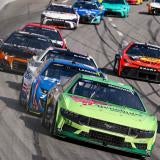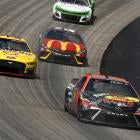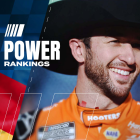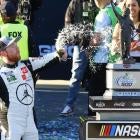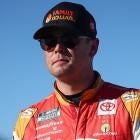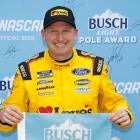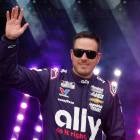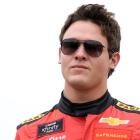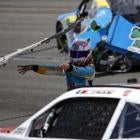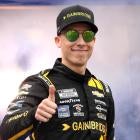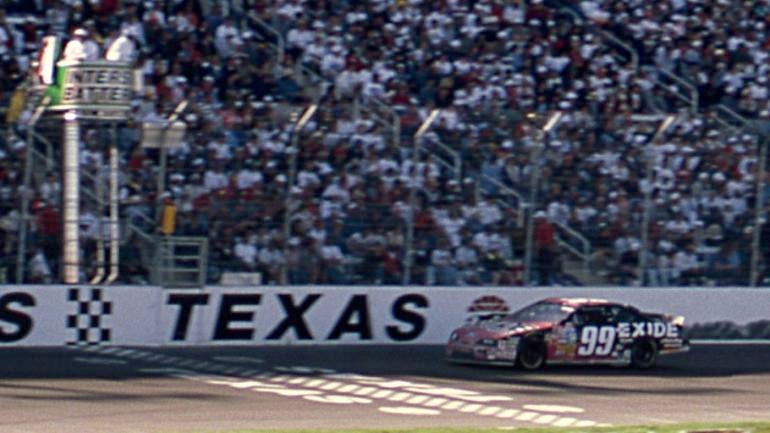
From 1979 to 2000, CBS Sports played a central role in shaping NASCAR into a national television sport, becoming the first network to televise the Daytona 500 live from start-to-finish while also bringing some of the sport's other major races to national television. Along the way, CBS created many racing and television memories that are still looked fondly upon by the NASCAR fans and competitors of today.
With over two decades of races to choose from, we're opening our vault to look back at some of the notable NASCAR races carried live on CBS. That begins this week with Texas Motor Speedway, whose Cup race was carried live on CBS from 1997 to 2000.
When the Texas Motor Speedway opened in 1997, it instantly became a symbol of NASCAR's track-building boom of the 1990s and all of the opulence that came with it. A passion project of NASCAR Hall of Fame track owner Bruton Smith, Texas resembled the famed Charlotte Motor Speedway as a 1.5-mile quad-oval, but somehow both looked and felt far grander in scale. That grandiose feeling was especially significant, as Texas had taken the place of North Wilkesboro Speedway on the Winston Cup schedule -- An explicit illustration that the sport was aggressively pursuing larger, newer tracks in major media markets, even at the cost of its heritage.
The inaugural Interstate Batteries 500 at Texas Motor Speedway promised to be one of the biggest events of the 1997 season, with an additional mile bringing the race length to 501 miles -- on account of everything being bigger in Texas -- driving the point home. But as so often happens in life, not everything ended up going smoothly as NASCAR made its first impression on the Dallas-Fort Worth area.
When cars first hit the track, Texas quickly proved extremely treacherous thanks to a severe drop off on the exit of turn 4 where the speedway's 24-degree banked turns abruptly met just five degrees of banking on the frontstraightaway. That section of the track would see a serious accident to start the weekend as Ricky Craven crashed, suffering a fractured shoulder blade and a concussion that sidelined him for the weekend. Todd Bodine would wind up driving the No. 25 Chevrolet for Hendrick Motorsports in his place.
Heavy rains would then wash qualifying away, putting Winston Cup points leader Dale Jarrett on the pole, before causing chaos for the speedway itself when the track's grass parking lots flooded and officials had to find ways to get fans into the stands in time for the green flag on Sunday. Those fans who made it to their seats at the green flag would then marvel at a 43-car field of NASCAR's best roaring into the first corner -- and 13 cars piling into each other after contact between Darrell Waltrip and Johnny Benson.
That crash set the tone for the day, as a high attrition rate would be responsible for jumbling up the field throughout the day. It made for an eventful race even in spite of a single-groove surface that made passing difficult, but that would be of no solace to some of stars of NASCAR who were ensnared by the 10 total cautions that flew.
The most serious wreck of the day occurred on the frontstretch on lap 162, as first Rusty Wallace and several other cars crashed in oil laid down from Ted Musgrave's car. Then, racing leader Terry Labonte back to the caution as he tried to get back on the lead lap, Ernie Irvan would slam straight into the back of Greg Sacks who was slowing down for the yellow flag, collecting Jeff Gordon in the process.
Labonte, the defending Winston Cup champion and a proud Texan from Corpus Christi, would wind up leading the most laps on the day with 104. The race looked to be shaping up as a battle between Labonte and Ricky Rudd, but that would change when a series of cautions following a long green flag run led to varying strategy plays that shook up the running order.
When Labonte and Rudd came to pit road late under caution to top off on fuel, that would open the door for Jeff Burton, who capitalized on his track position to run down Todd Bodine for the race lead. Burton's move for the lead came with 58 laps to go, when he quickly ran down Bodine on the exit of turn 2, leading to Bodine's car getting loose and spinning into the outside wall as Burton drove away.
Despite engine troubles for both of his Roush Racing teammates in Mark Martin and Ted Musgrave, and despite pit road problems that had cost him a lap earlier in the day despite a fast car, everything would go right for Burton from there as he led the rest of the race and earned his very first Winston Cup victory. It was a well-earned breakthrough for the 1994 Rookie of the Year, who had shown great promise and growth after joining Roush in 1996 but to that point had yet to have it pay off in a trip to the Winner's Circle.
"This team has been working really hard. We've lost more than we've won, that's for sure," Burton told CBS Sports in Victory Lane. "We've given a few away -- We didn't give this one away."
Dale Jarrett would finish second despite a faulty clutch, allowing him to hold a 95-point lead in the Winston Cup standings, while the Labonte brothers Bobby and Terry would finish third and fourth. Ricky Rudd would round out the top five in fifth.
Notes from the Race
- As he oversaw his No. 18 Pontiac driven by Bobby Labonte on in the event, CBS Sports interviewed Joe Gibbs on pit road to get his reaction to the passing of Washington Redskins owner Jack Kent Cooke, who had died of heart failure the morning of the race. Gibbs had coached Washington's NFL team to three Super Bowls under Cooke's ownership, but the Cooke family was unable to maintain ownership and sold the team to Dan Snyder in 1999.
- An early crash continued what was a brutal start to the year for Bobby Hillin, as it marked his fifth DNF in five races he had qualified for to start 1997 driving for Jasper Motorsports. Hillin would leave the team following Pocono in June, with car owner Doug Bawel replacing him with Morgan Shepherd and eventually Robert Pressley.
- After winning Saturday's Busch Series race, Mark Martin ran up front early and would lead 10 laps before the engine blew on his No. 6 Ford. Race weekend in Texas also saw Martin's sponsor Vavoline announce that it had renewed for three more seasons with Martin and Roush Racing, which took their partnership through the 2000 season.
- Greg Sacks' car featured a curious detail, as the name "D.J. Tucker" was placed on the name rail in place of Sacks'. Tucker was a character in Steel Chariots, a made-for-TV movie set in NASCAR that car owner Harry Ranier's No. 20 team was providing support for the filming of. Interestingly, the actor who played D.J. Tucker, Ben Browder, was the brother of Busch Series car owner Dan Browder.
- Steve Grissom's team experienced mid-race radio problems that prevented them from communicating properly with their driver, which led to them employing an interesting way of calling their driver to pit road: During a cycle of green flag stops, the Larry Hedrick Motorsports team had NASCAR black flag the No. 41 Chevrolet in order to get Grissom to make his trip to pit road for service. The assist from NASCAR officials would pay off as Grissom came home 10th, earning his first top 10 finish of the season.
- Joe Nemechek made his return to the Team SABCO No. 42 for this race, as he had skipped the previous race at Darlington after his brother John died of a head injury suffered in a crash during a Craftsman Truck Series race at Homestead. Nemechek would fail to finish after a hard head-to-head collision with Johnny Benson late in the race, but he would go on to name his newborn son -- current NASCAR Cup Series driver John Hunter Nemechek -- after his brother later that year.
- The crash that took out Nemechek and Benson also took out Chad Little, who was also on baby watch as his wife was overdue with their first child. That child would turn out to be son Jesse Little, who later went on to race in NASCAR before joining his father in working as a NASCAR official.
- Midway through the race, CBS Sports interviewed Olympic gold medal sprinter Michael Johnson, who was attending his first NASCAR race as a guest of Terry Labonte's team. Johnson was preparing for a June 1 match race against Donovan Bailey, one which was billed as settling a dispute in the "World's Fastest Man" title. Bailey would end up winning as Johnson failed to finish after pulling a quad muscle.
- In the broadcast booth for CBS Sports was two-time Cup champion Ned Jarrett, who received mid-race congratulations for receiving an honorary doctorate in humanities from Lenoir-Rhyne College in his native Hickory, N.C., Jarrett served as an analyst alongside Ken Squier and Buddy Baker in the booth, with Mike Joy, Dick Bergrenn and Ralph Shaheen serving as pit reporters.
1997 Interstate Batteries 500 results
- #99 - Jeff Burton
- #88 - Dale Jarrett
- #18 - Bobby Labonte
- #5 - Terry Labonte
- #10 - Ricky Rudd
- #3 - Dale Earnhardt
- #22 - Ward Burton
- #4 - Sterling Marlin
- #21 - Michael Waltrip
- #41 - Steve Grissom
- #94 - Bill Elliott
- #98 - John Andretti
- #81 - Kenny Wallace
- #7 - Geoff Bodine
- #71 - Dave Marcis
- #9 - Lake Speed
- #91 - Mike Wallace
- #33 - Ken Schrader
- #11 - Brett Bodine
- #43 - Bobby Hamilton
- #78 - Billy Standridge
- #31 - Mike Skinner
- #90 - Dick Trickle
- #1 - Morgan Shepherd
- #25 - Todd Bodine
- #97 - Chad Little
- #44 - Kyle Petty
- #30 - Johnny Benson
- #42 - Joe Nemechek
- #24 - Jeff Gordon
- #75 - Rick Mast
- #37 - Jeremy Mayfield
- #8 - Hut Stricklin
- #40 - Robby Gordon
- #16 - Ted Musgrave
- #28 - Ernie Irvan
- #2 - Rusty Wallace
- #6 - Mark Martin
- #23 - Jimmy Spencer
- #20 - Greg Sacks
- #36 - Derrike Cope
- #77 - Bobby Hillin Jr.
- #17 - Darrell Waltrip








